Organizational Alignment: The 2025 Guide

If companies are not aligned to a central strategic goal, the results often fall short of expectations. organizational alignment can eliminate this problem and ensure effective processes throughout the company.
In this guide, we show the biggest challenges in strategic alignment and which methods and frameworks can be used to overcome them.
Table of contents:
- What is organizational alignment? Definition
- Typical alignment challenges in companies
- Why is organizational alignment important?
- Benefits of organizational alignment
- How to create organizational alignment? Methods and frameworks
- Focus: Using OKRs to ensure alignment
- How can you measure organizational alignment?
- How Mooncamp supports organizational alignment
- Conclusion: OKRs ensure alignment in all directions
What is organizational alignment? Definition
Organizational alignment means the alignment of different processes, departments and products towards a common goal. Instead of having each team work in isolation, a joint approach is sought.
Organizational alignment pursues the following goals:
- Increase efficiency through optimal use of resources
- Promote a coherent corporate culture through common goals
- Avoid silo thinking and isolated work through common goals
A fundamental distinction is made in organizational alignment between
- vertical alignment and
- horizontal alignment.
Vertical vs. horizontal alignment
In horizontal alignment, figuratively speaking, all departments are considered on one level. The point here is not that all departments pursue one and the same goal. What is more important is how the goals of the individual teams relate to and contribute to each other. By looking at this overall picture, similarities and differences can be identified and priorities can be derived. Synergies also become visible. The teams recognize better which challenges they can support each other with and how they can coordinate this support. As each department knows what the other is currently working on, duplication of work can be avoided. As a result, the teams work more efficiently overall. Capacities and resources are allocated more effectively, which increases the efficiency of the entire company.
With vertical alignment, it is not the departments that are considered, but the different hierarchies. Starting from the bottom up - or vice versa - as on a vertical line, we look at how the objectives of the individual levels affect each other. In this way, individual goals can be aligned with team goals and ultimately with the overarching goal of the organization. All employees should understand how their work contributes to the goals of the next level up. Each level also has clear responsibilities. If everyone knows how they individually contribute to achieving the company's goals, this automatically leads to the entire company pulling in the same direction. Overall, this creates a more harmonious and productive collaboration that contributes to an overarching goal.
Both vertical and horizontal alignment are necessary for companies to really work successfully towards a common goal and for strategy implementation to succeed. This is the only way to achieve effective collaboration that keeps the big picture in mind.
Other types of alignment
In addition to the basic horizontal and vertical alignment, there are other specific forms of organizational alignment. These focus on different aspects or levels of the organization. Some examples are:
Strategic alignment
Strategic alignment consciously aligns all organizational elements, processes and resources to a common strategic vision and mission. Like a cogwheel, all elements should interlock. All levels of the organization then work together to realize the corporate strategy.
The biggest challenge usually lies in the bridge that needs to be built between strategy development and implementation.
North Star Alignment
This type of alignment is often very product-oriented. A single, essential metric is identified as the North Star - a kind of shining star that everyone can see and in whose direction they are moving together. This could be, for example, the maximum sales of a product or a certain number of monthly subscribers.
Companies first analyze a range of data to gain an overview of the current situation. They then develop a strategy on how to improve the status quo. All team members then align their operational efforts with this strategy to realize the targeted North Star metric.
Customer Alignment
Customer alignment focuses on the needs of the customer throughout the entire value chain, from product development to support. All processes and all employees are geared towards giving customers exactly what they need - true to the motto: the customer is king (or queen). Working in a customer-centric manner is understood as a corporate philosophy and is practiced holistically. This includes, for example, constantly gathering customer feedback and integrating it into product development.
Aligned Autonomy
In aligned autonomy (also known as the Spotify model), companies give their employees just enough structure and support to enable them to find the best way to achieve a predefined, overarching goal on their own. The agile method therefore relies on as much self-organization as possible with a minimum of direction. This means that employees act largely independently within the set guidelines.
The workforce is divided into different units with names reminiscent of a multiplayer online game:
- Squads: Small, interdisciplinary units (8 to 10 people) that act autonomously
- Tribes: A group of several squads that work together on a goal or project
- Chapters: Specialist network within the tribes that is comparable to traditional departments (e.g. equivalent to the marketing department)
- Guilds: Voluntary communities in which employees exchange ideas on topics of their choice
Supported by shared values and guidelines, this structure promotes agility and personal responsibility.

Typical alignment challenges in companies
Many companies find it difficult to create synergy between different departments. There are many reasons for this. They range from a lack of planning to unclear responsibilities.
Typical problems that companies have with organizational alignment include:
- No clear strategy: An unclear or missing overall strategy can lead to individual departments pursuing different goals. This sometimes leads to horizontal and vertical misunderstandings and resentment among employees.
- Lack of responsibilities: Unclear responsibilities, both at company level and in individual roles, often cause problems. Clearly assigned areas of responsibility are therefore essential.
- Individual initiatives instead of team thinking: Isolated work and a lack of team thinking lead to individual initiative, promote silo thinking and make it difficult to achieve goals. Companies should therefore actively involve their employees in the entire process in order to motivate them and increase overall performance.
- Poor internal communication: Transparency, regular updates and feedback sessions are essential to prevent misunderstandings and maintain a clear flow of information.
- Lack of evaluation: Detailed monitoring ensures that progress and strategic direction can be evaluated and reviewed.
- Resistance to change: If employees resist change, this is often due to unclear communication or because their input seems unimportant. Clarification breaks down barriers here.
- Lack of flexibility: Agile project management enables a rapid response to change, which makes companies competitive in the long term.
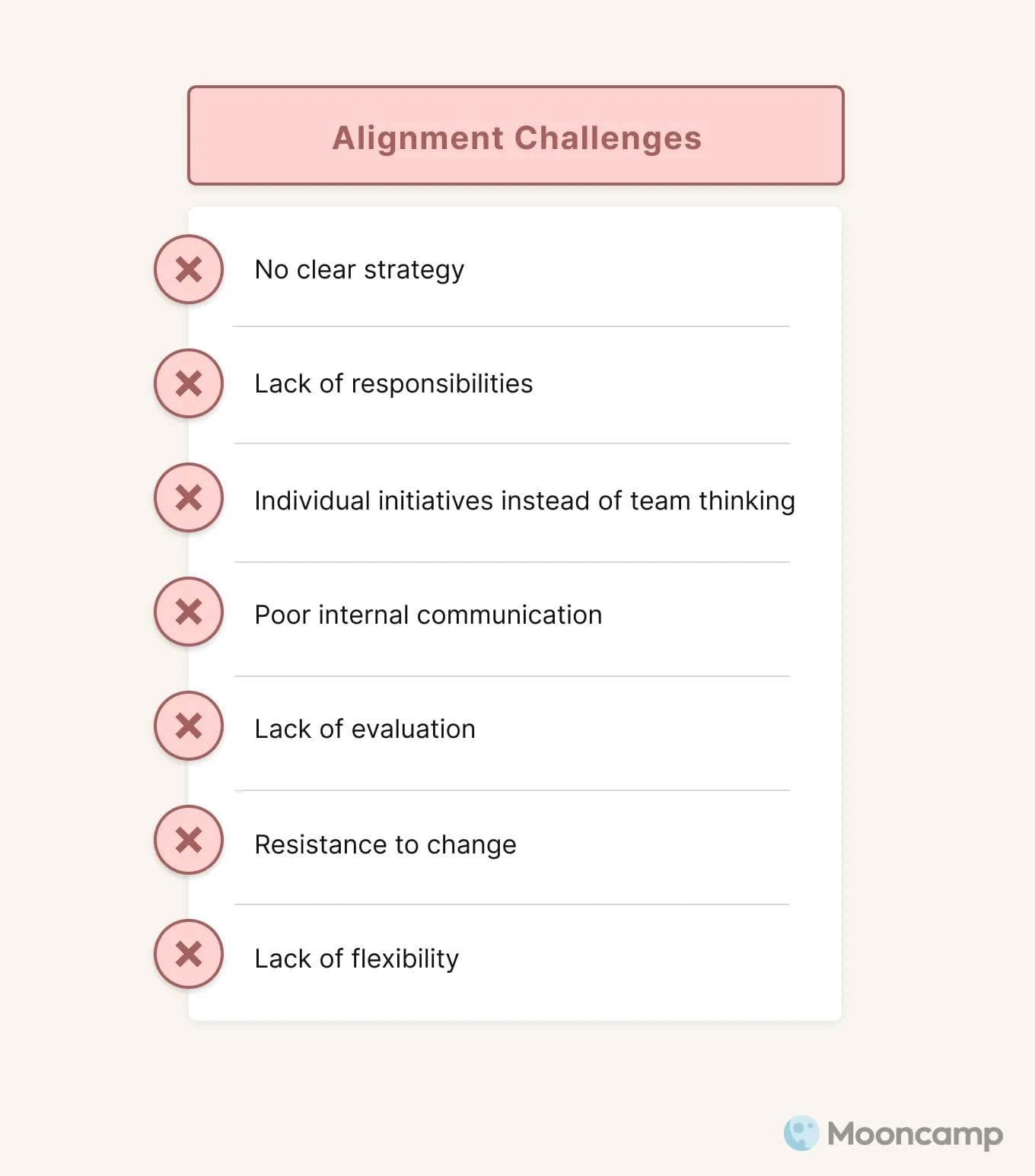
Why is organizational alignment important?
Vertical and horizontal alignment helps companies to systematically pursue overarching goals. In large companies in particular, it is otherwise easy for one department not to know what the other one is actually doing. Organizational alignment ensures that all parts of an organization work together in the best possible way and pursue common goals. If the individual goals are not aligned
- errors at work,
- lack of coordination and
- lack of agility
are inevitable. These problems then unavoidably have a negative impact on the company's financial resources.
There are countless companies that believe they can get by without organizational alignment. Unfortunately, many forget the long-term consequences. It's not just company and sales growth that fails to materialize. Poor coordination also has an internal impact on employee satisfaction. Important talents leave the company or even switch to the competition.
If there is a lack of strategic alignment, competitiveness also declines. If companies are unable to react quickly to changing market conditions because they work with rigid structures, the competition will pass them by. All in all, mistakes and high costs are practically inevitable without organizational alignment.
Advantages of organizational alignment
Working systematically towards an overarching goal with a common focus has several advantages:
- Increased efficiency: Redundant activities are avoided and resources are optimally utilized.
- Clear communication: Transparent information flows promote cooperation and minimize misunderstandings.
- Employee motivation: Employees are more motivated because they understand the impact of their work on the overall strategy and can therefore identify better with the company's goals.
- Adaptability: Departments work together in a coordinated manner and can react more quickly to changes.
- Competitiveness: Competitiveness is strengthened through effective resource allocation and high adaptability.
In summary, organizational alignment creates an end-to-end value chain, supports the development of a coherent corporate culture and enables agile responses to changing market conditions.
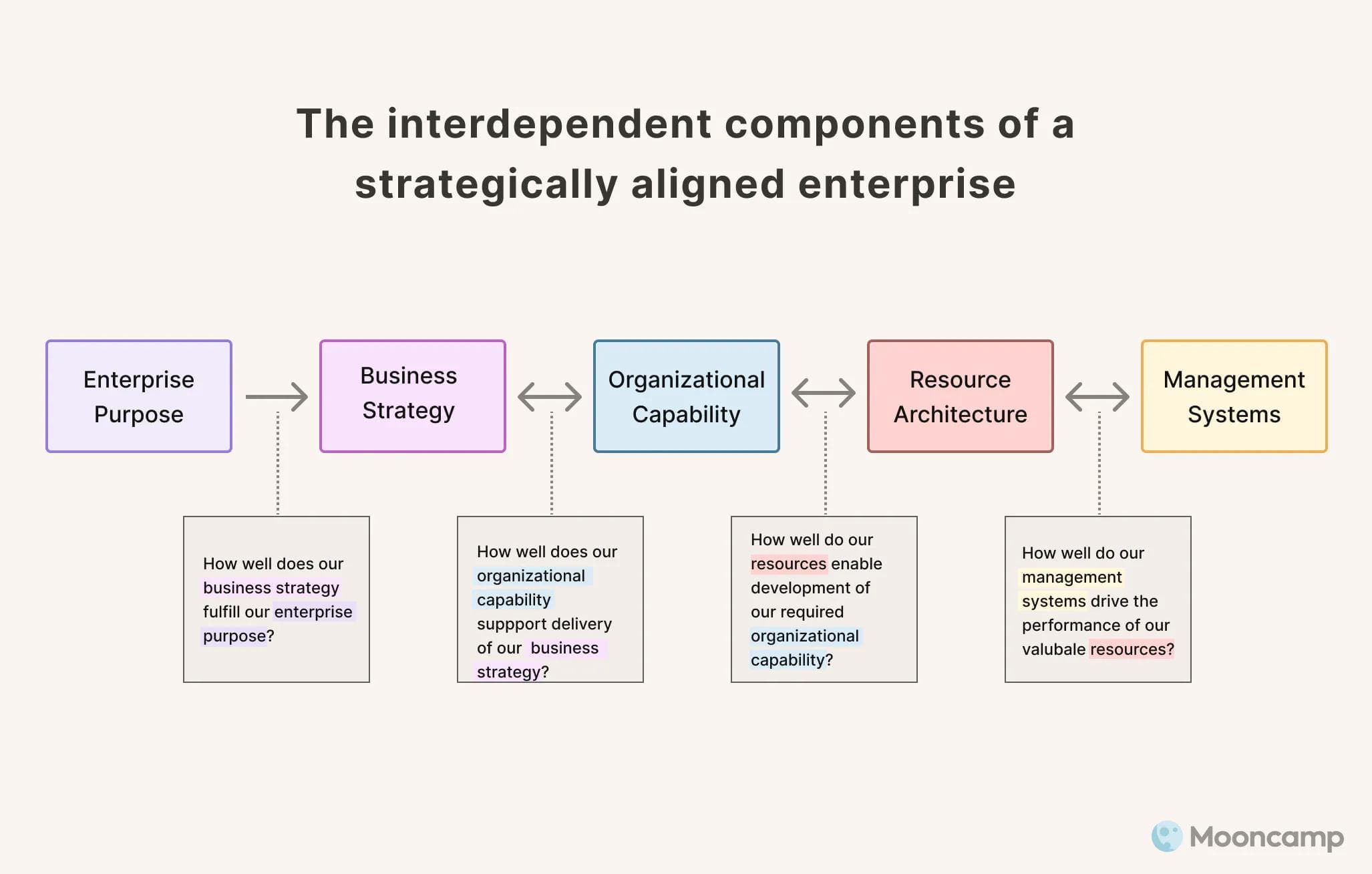
How do you create organizational alignment? Methods and frameworks
To ensure that everyone in the company is aligned towards a common goal, there are various methods and frameworks. OKRs, OGSM, 4DX or McKinsey's 7-S model, for example, have proven their worth.
OKRs (Objectives and Key Results)
OKRs are a particularly effective method for organizational alignment. Top-down and bottom-up goals are usually set. To this end, management first develops corporate OKRs, which are then communicated transparently and serve as the basis of the team OKRs. Alignment is an integral part of the framework.
💡 As a reminder: OKR (short for "Objectives and Key Results") is an agile framework for formulating and implementing strategic goals in companies, which consists of three core elements:
- Objectives: What do I want to achieve?
- Key Results: How do I know that the Objective has been achieved?
- Initiatives: How do I achieve the Objective?
As a rule, 2 to 4 Objectives are formulated per team and 2 to 4 Key Results per Objective. The output is mapped in initiatives (= concrete activities). More basic knowledge can be found in our guide to the OKR method.
It is important that all employees understand the common goals and know what greater purpose they contribute to. Ideally, all teams and employees will then pull in the same direction.
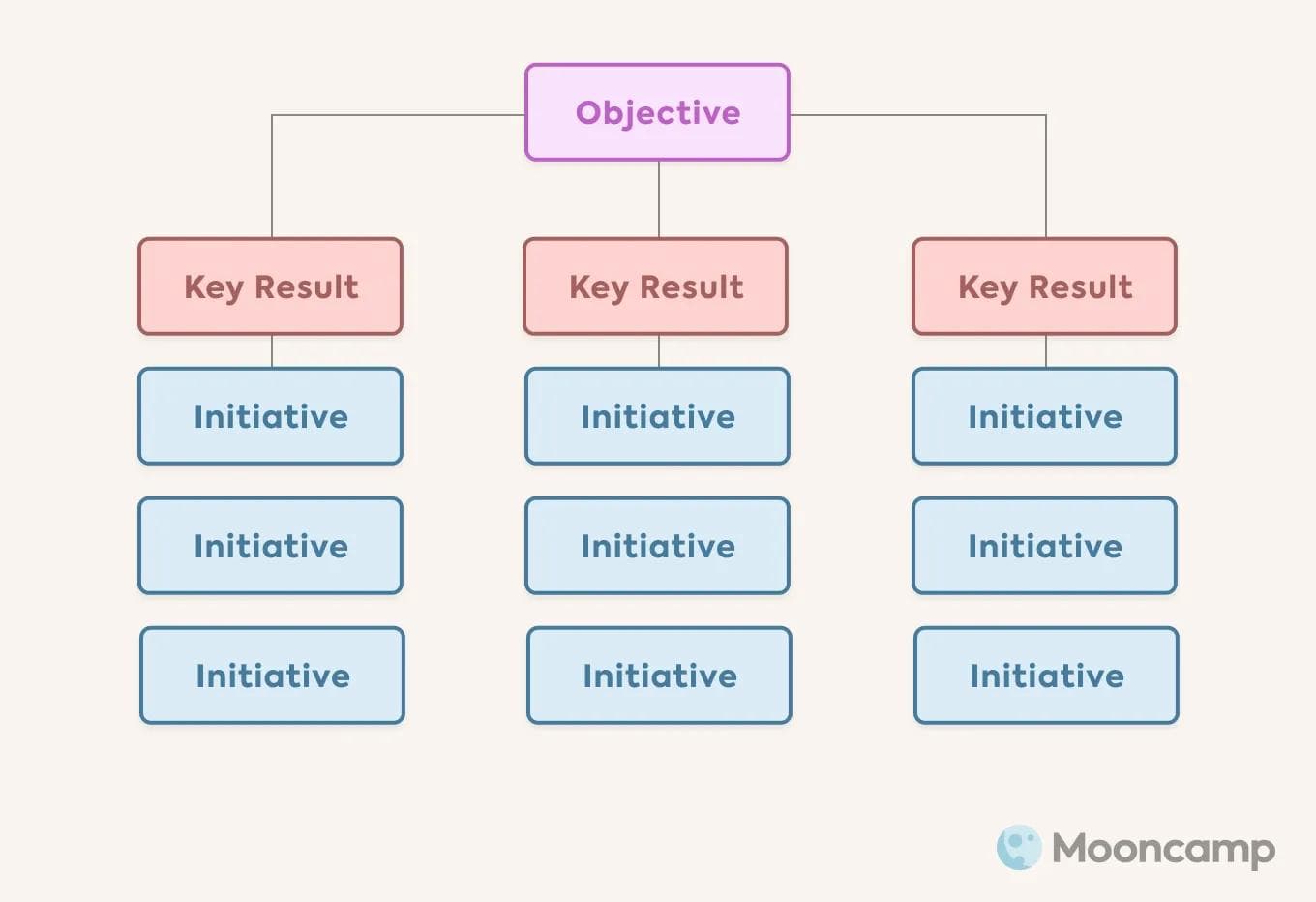
The OKR method also promotes cross-functional collaboration. Silos are broken down when OKRs are jointly developed and coordinated between teams and departments.
💡 Tip: All OKR benefits can be read up on on our blog.
OGSM
OGSM (Objectives, Goals, Strategies and Measures) is a widely used framework that provides a structure for defining and implementing long-term goals at all levels of the organization. To this end, companies break down at management level what they want to achieve and what specific measures they will use to do so. The goals should always be in line with the overarching corporate strategy. In this way, the most effective path for the entire company is worked out together. Measurable targets make progress along the way visible. Regular reviews ensure that the organization stays on the right course.
In contrast to OKRs, OGSMs are geared towards long-term goals. Furthermore, OGSM targets are only communicated top-down. OGSM is therefore less agile and the goals cannot be adjusted as quickly.
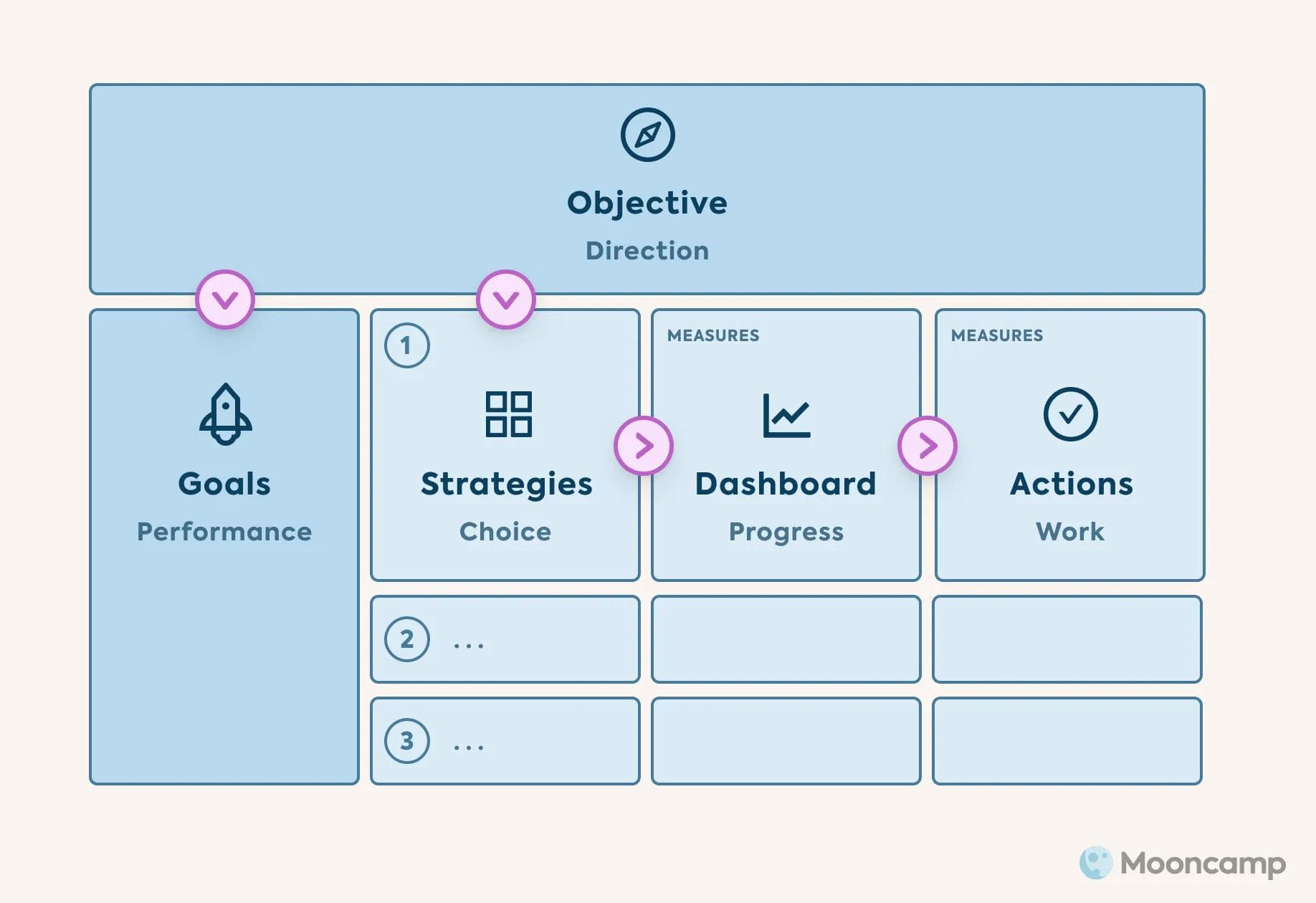
4DX
The 4DX method (short for "Four Disciplines of Execution") is designed to help managers realize their goals. It begins with the identification of the "Wildly Important Goals" (WIGs), which have a decisive influence on the company's success.
- Focus on the essentials
- Implementation of decisive measures
- Meaningful scoreboard
- Rhythm of responsibilities
The focus is on a few key objectives that are presented in a very simple way. Clear key figures ensure that progress can be tracked precisely. This guarantees a goal-oriented focus and transparency within the company. However, 4DX also requires a very high degree of discipline until the method is anchored in the company.
7-S model from McKinsey
McKinsey's 7-S model identifies seven key elements that are necessary for successful strategy implementation. These are divided into three hard elements:
- Strategy
- Structure
- Systems
and four soft elements:
- Style
- Staff
- Skills
- Shared Values
The model helps to identify inconsistencies and problems and to derive measures – such as training, structural adjustments or the promotion of corporate values.
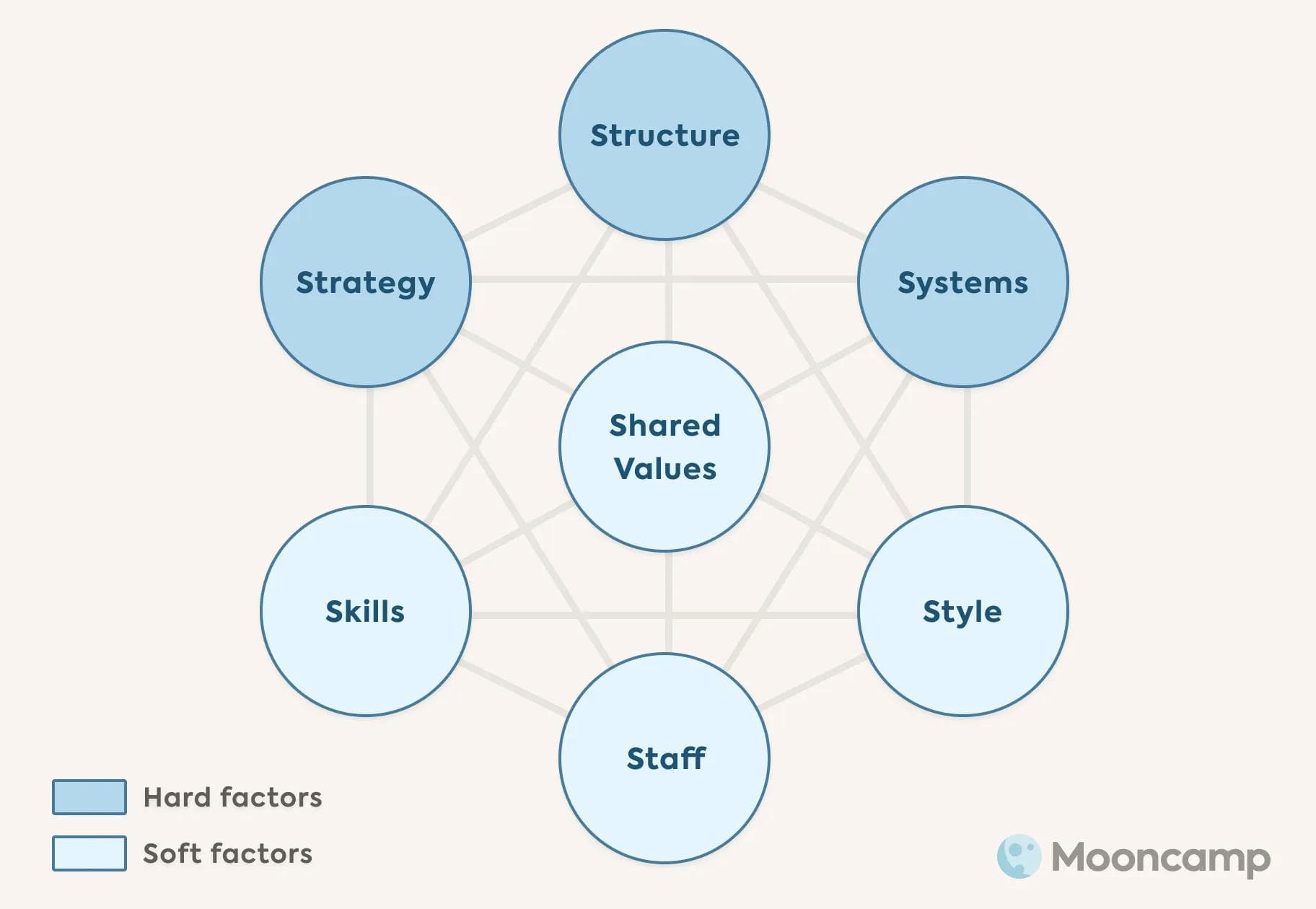
In the following, we take a closer look at how OKRs can create organizational alignment in practice.
Spotlight: Ensuring alignment with OKRs
OKRs are more than just goals - they are the engine for efficient alignment in an organization. From the top to the bottom, OKRs create a collective alignment that ensures companies achieve their overall vision. There are two key reasons for this:
1. Alignment workshops are firmly anchored in the OKR cycle
The OKR Alignment Workshop is a crucial part of the OKR cycle. It provides an interactive platform for setting priorities and focusing on what is most important for the near future. It also serves to ensure the vertical and horizontal alignment of the OKRs by aligning the goals of all teams.
The aim is to work out which other teams your own team is dependent on on the way to achieving its goals. The alignment workshop therefore ensures that everyone really is working together smoothly in the same direction.
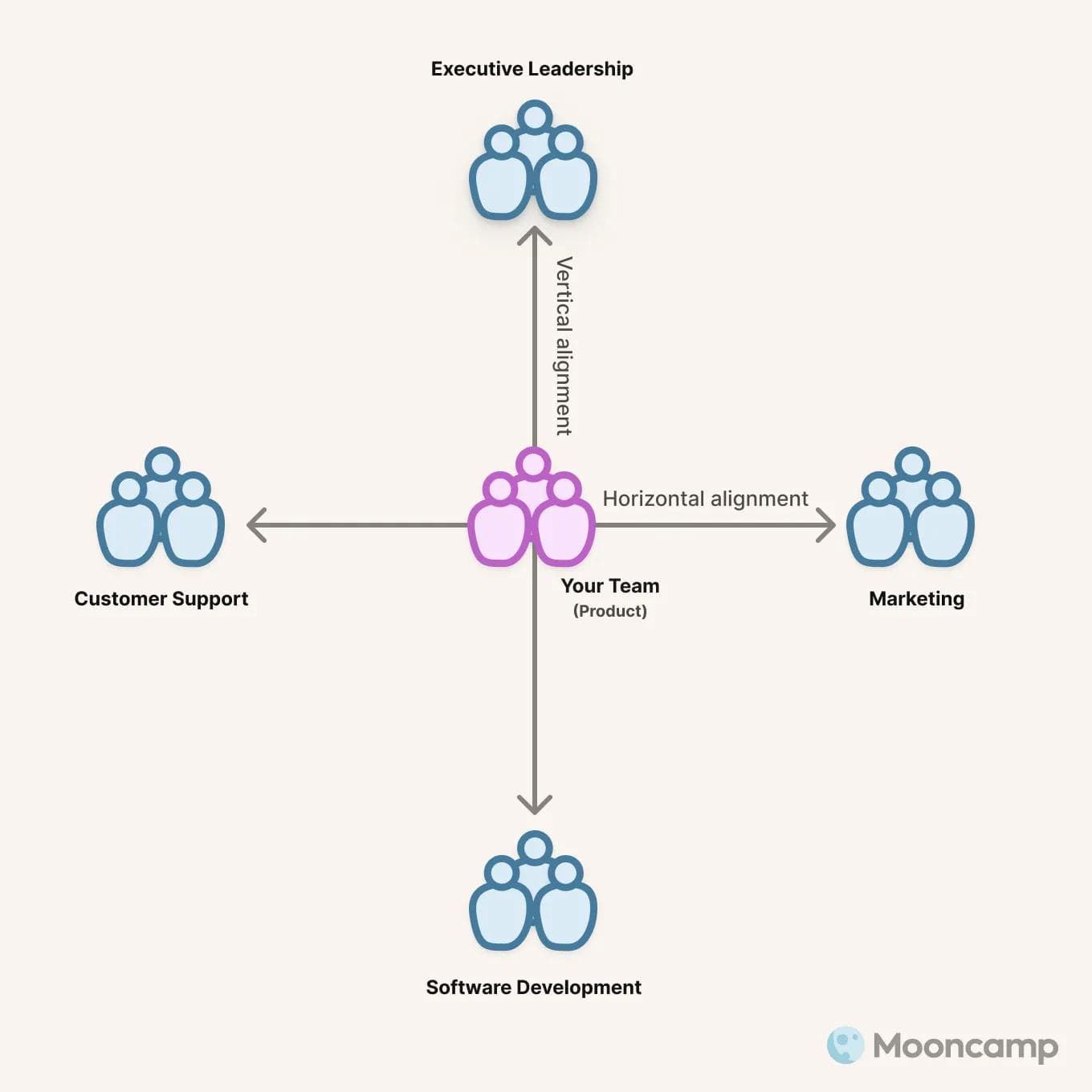
For example, if the sales team knows that the marketing department wants to tackle Account Based Marketing in the next quarter, they can align their sales goals accordingly. Both teams can then align their OKRs precisely and thus keep an eye on the big picture.
💡 Tip: We have summarized the elements of an OKR workshop on our blog – including an agenda for the process.
2. OKRs create transparency and focus
OKRs are usually limited to 2 to 4 Objectives per team and 2 to four 4 Results per Objective. This limitation helps to focus on the essentials in day-to-day work and only drive forward the most important projects per cycle. Ideally, the most important projects are those that advance the corporate strategy the most. Less urgent goals are postponed to the next cycle. Overall, this increases the organizational focus.
In addition, the typical events in the OKR cycle – especially the weekly OKR check-ins – ensure that all employees know at all times what progress has already been made in achieving the objectives. All employees have an insight into the OKRs and progress. Who is currently working on what is shared transparently. The entire company is therefore on the same page. If necessary, countermeasures can be taken promptly if individual targets are no longer on track.
How can organizational alignment be measured?
There are various methods for measuring how successful the chosen alignment strategy is and how the strategic alignment is progressing:
1. Conducting employee surveys
Direct feedback from employees makes opinions on goals, communication and the general alignment within the organization visible. The easiest way for managers to obtain this is through short surveys. This gives them an insight into how effective organizational alignment is from an internal perspective. In most cases, short statements on a specific topic are used, which employees agree with to a greater or lesser extent on a scale of 1 to 5.
2. Using the organizational alignment survey (OAS)
A special type of organizational alignment survey is the OAS. The methodology was developed by Shaun Smith. It uses twelve internal and external key factors to examine where a company stands in terms of alignment with business objectives. In contrast to conventional surveys, the OAS not only provides data, but also knowledge.
The questionnaire covers the following factors:
- Market orientation
- Mission statement and goals
- Corporate culture
- Guidelines and processes
- Service quality
- Personnel policy
- Climate
- Total quality
- Leadership behavior
- Uniqueness of products or services
- Corporate environment
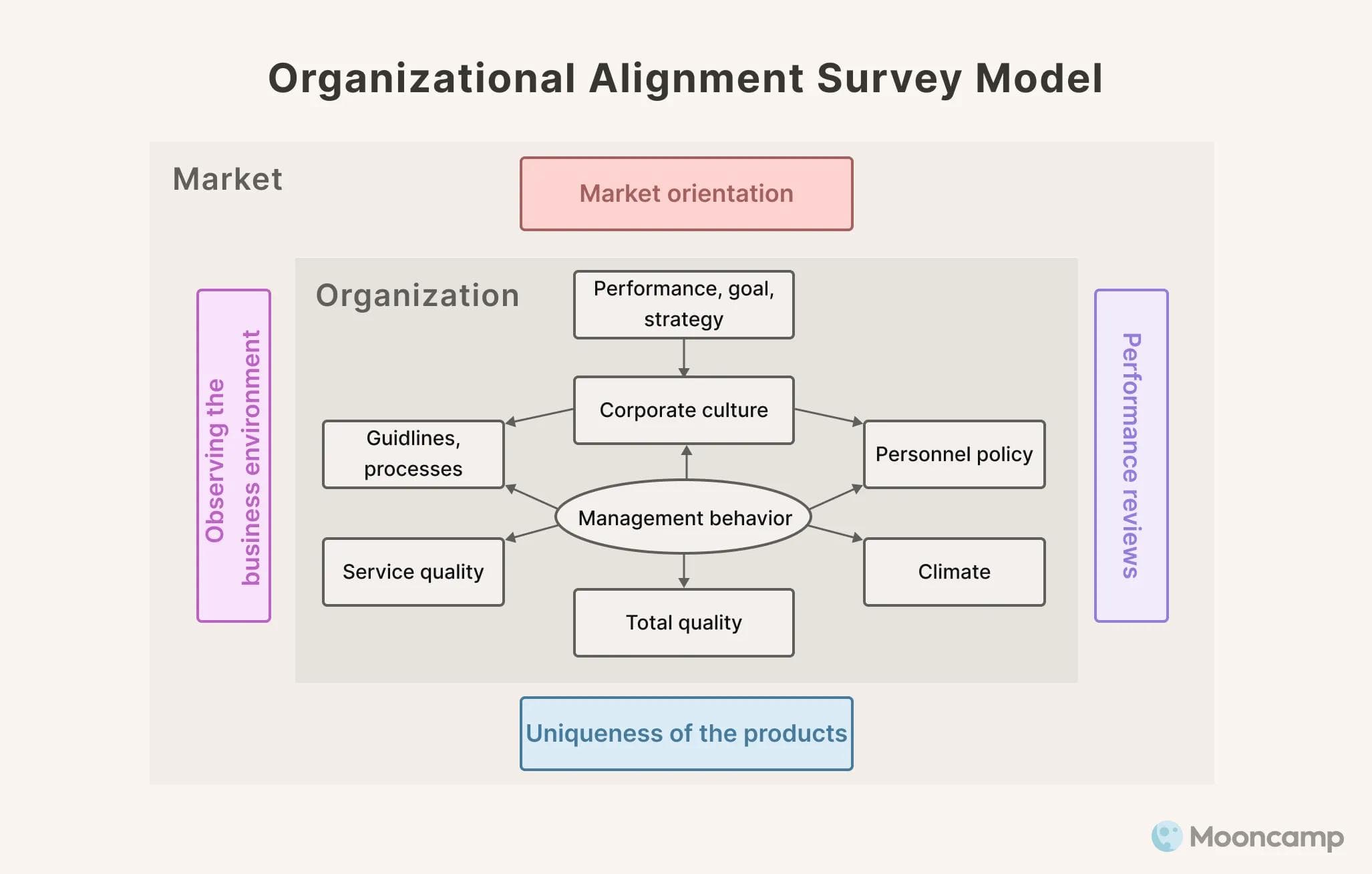
In a 13th component, the discrepancy between the actual performance and the perception within the company is then analyzed. This allows the gaps that prevent companies from achieving organizational alignment to be uncovered.
3. Use Strategy Execution software such as Mooncamp
In OKR software such as Mooncamp, all important information is in one place. Goals, structures and progress are visualized and dependencies are visible. This allows each team member to quickly see which goals are related and how, and it becomes clear at a glance where alignment may still be lacking. The visualization can also have a motivating effect because the team understands more quickly how their own work contributes to the overall success of the organization.
The software also is a hub for internal communication around goals and strategy. Employees can see who is working on which goal at any given time. This promotes transparency within the company and facilitates alignment.
How Mooncamp supports organizational alignment
Specifically, Mooncamp helps companies to define and track OKRs. Mooncamp visualizes all goals, structures and progress centrally in one place – regardless of the number of OKRs and the size of the company. Integrated check-ins also ensure that everyone keeps their OKRs in focus and does not lose sight of the big picture.
The Goal Tree is particularly helpful here. It provides an interactive overview of the strategic pillars and goals of all hierarchy levels. The visual overview can be used like a drawing board. This makes it particularly easy to keep an eye on the overall corporate goal. At the same time, teams and departments can coordinate with each other using the Goal Tree, as they can see which goals other teams are currently working on.
With the individually configurable dashboards, all important key figures and progress as well as the vision, mission and values of the company can also be displayed in Mooncamp in a company overview. The dashboards can also be displayed publicly or privately and shared with selected access groups. This makes them ideal for coordination and meetings.
💡 Tip: For anyone who wants to know what organizational alignment with OKR software can look like in practice, it's worth taking a look at our success stories.
Conclusion: OKRs ensure alignment in all directions
Overall, the following applies: Organizational alignment enables effective strategy implementation and is therefore an important lever for corporate success. OKRs can ensure good vertical as well as horizontal alignment. If OKRs are aligned across departments and to a common corporate goal, the entire organization is aligned. Similar to a correctly set sail, the entire boat moves in the intended direction.
With OKR software, goals are also managed and visible in one central location. This facilitates internal collaboration and promotes transparent exchange. The advantages that organizational alignment has for companies can thus be realized more easily and efficiently.

